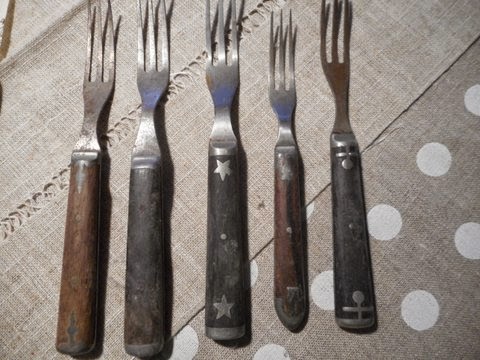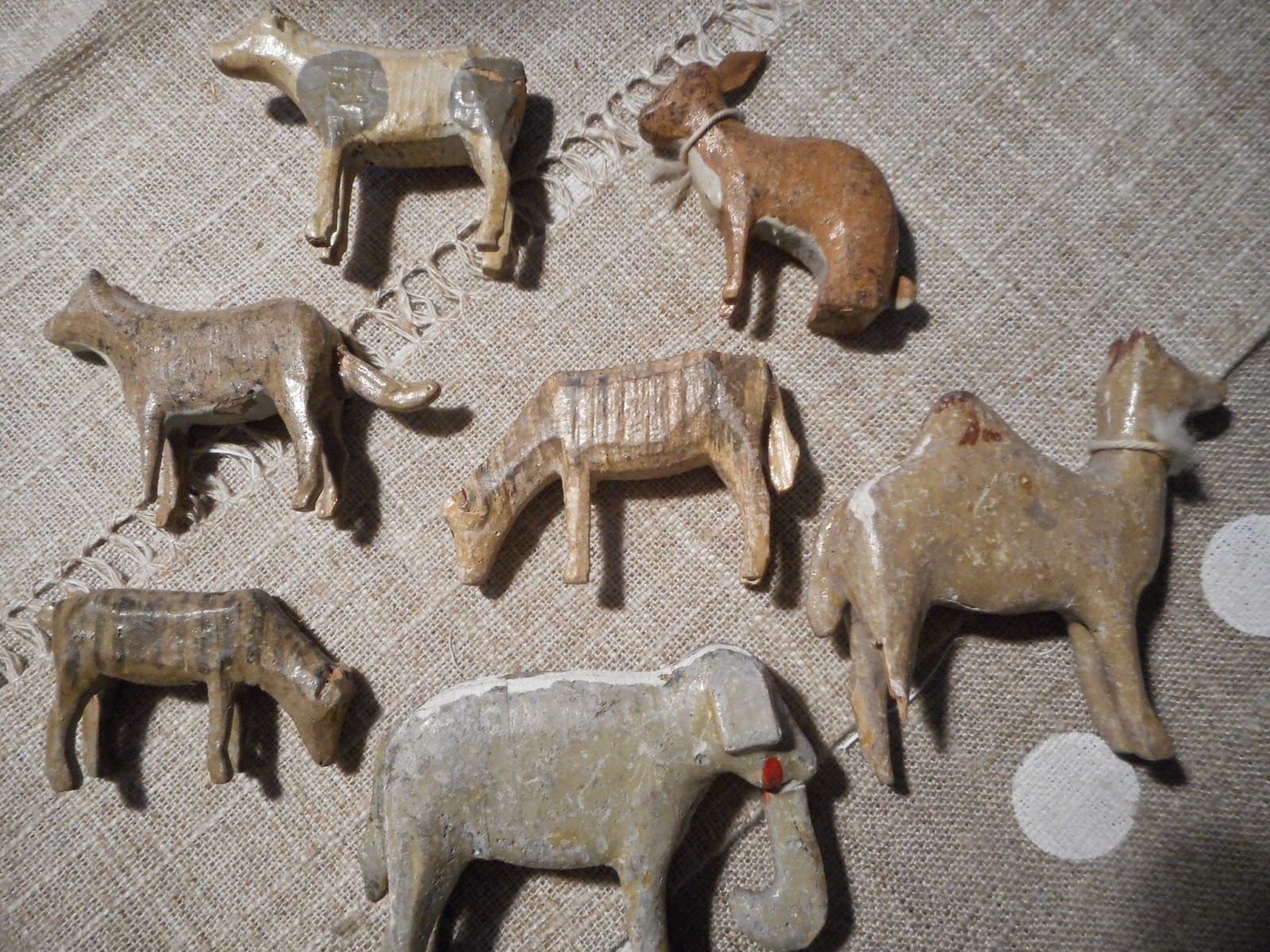Wednesday, December 31, 2014
New Year's Pretzel
Holiday baking in Amana is and was always special with many generations of a family baking together in the kitchen, whether it was the old community kitchen or their modern one. Historically, the baking was done at the communal kitchen or the bakery as they were the only places with hearth ovens. In December the Elders and bakers would assign each family a baking day to use this old fashioned oven for their holiday cookies, drops, breads, and Stollen and the special, Pretzel. On New Years Day it was and is very much a tradition to serve Pretzel, pretzel shaped yeast bread or coffee cake. It is very light and sweet, often frosted with white icing. Some add shredded coconut, some add nuts. It is delicious, baked just before New Years Eve, served fresh it makes the holiday so special. 2troxelphotos
Amana Cakes
At a traditional Old Amana wedding, held in the main church, the bride and groom stood before the Elder and congregation, together, for the first time on THAT day, their wedding day. They had been separated beforehand to prove their love for each other. At the wedding there were no rings, no flowers, no color, no attendants. Afterwards, the bride's family went up to the kitchen house for a luncheon and where there were many traditional cakes to be served. A later reception was held at the groom's home for more fun.. The cakes were and still are special, beautiful, luscious, tasty and plentiful. Some 30 cakes had 2-3 layers, rich with nuts, chocolate, coconut, carmel, angel food, and the main Sternkuchen or star-shaped cake, from a mold made by the local tinsmith, was a standout. In the past, the cakes were made by the ladies of the kitchen house, now by friends, relatives, and church ladies, always the center of interest at a wedding reception. They were displayed for all to enjoy and later whisked away to be sliced and arranged on trays for ease of serving. The tradition of cakes is still enjoyed at weddings, funerals, and graduations. My favorite was always Marie S.'s poppy seed cake with vanilla sauce which she made for our wedding. 4troxelphotos
Tuesday, December 30, 2014
Amana Bakeries
Each Amana village once had a non-commercial bakery to supply fresh bread and pastries to the local community kitchens which served about 40 people each meal. The baker would pull up to the kitchen in his horse drawn wagon, ring a bell and a worker would come out and tell him how many loaves they would need, some 12 for the day. On Saturdays he would deliver special pastries for Sunday morning, the fruit- filled coffee cake. The recipes were based on German ones as black bread, round white and round bread, and long loaves, some 3,000 loaves a day from 70 batches of dough. Two large grist mills processed grain into flour for the many bakeries of which four consolidated in 1943 and moved to Upper South, then became commercial with fuel oil ovens, the modern equipment, run many years by the Bringham family. The 147 year old brick building, originally opened as a general store in the 1800's, closed as of 2013 and baking Amana brand was hired out to Baker's Pride in Burlington, Iowa. Only one open hearth bakery remains as part of a home in Middle, no longer uses cut wood but gas fuel, with products made much like those from early Amana and the Hahn family. All the breads are still very much a local favorite addition to any meal!
Monday, December 29, 2014
Upper and Lower South Amana Hotels
Two young sisters from Ohio, Ms. Siegel and Ms. Zierold, were managers of the upper South Hotel when it was built in 1884. Later in 1887, Ms. Siegel managerd the lower South Amana Hotel. The young ladies were first maids and servers, then managers. This hotel, one that got to be 48 years old with 14 guest rooms, a kitchen, and a huge garden, was known for good German-like food with fresh vegetables grown in cellar dirt or sand boxes if not in fresh gardens. They rarely opened a can, all was fresh. Spinach and beets were very popular there.The hotel was near the town bakery as well, that now is closed and baking taking place in Burlington, Iowa, with products sold in Amanas still. Visitors and salesmen came from all over the world as the Amanas, which lay near railroads and newly paved highways, became more popular with tourists curious about communal life and activities at the University of Iowa. There would be some 25 guests at the breakfast table in those days. Guests came from Iowa City, Cedar Rapids, Marengo, Germany, England, Japan, as the towns lay on the C.R.I.P. railroad near where calico and woolen goods stores were bought. The guests were taxied between the upper and lower hotels by horse drawn carriages. In the 1950's, the Setzer and Ruff families each bought a side of the lower hotel from the Siegel sisters. The buildings still stand in Upper and Lower South Amana, one now for sale by the Amana Colonies Historical Sites Foundation as it was vacant for 20 years and needs lots of TLC, the one(lower) a home and apartments. Old Photos Amana Heritage Society
Saturday, December 27, 2014
Heirloom Seed Bank of Amana
AMANA gardeners grew as much of their own harvested seed as possible. Some seeds were not available in USA catalogs so local varieties that were obtained from dependable growers or from Germany to Ebenezer that the Inspirationists carried, were carefully preserved. Sometimes new plant varieties were developed in Amana communal kitchen gardens, so those seeds were well cared for, saved, and passed on to future gardeners. There is an effort now, since 1985, to collect and distribute historical seeds through the Amana Heritage Foundation or South Amana grower. Historic plant varieties as Amana string bean, Ebenezer onion, leaf lettuce, multicolored radish, cotton melon, celestial, European black falsify and ground cherry are a few to mention. Many ancestors of the Amana Inspirationists from Germany rescued and saved seed varieties that were brought to America by boat, some tucked in coat pockets. These seeds were then planted in community kitchen gardens in Ebenezer, NY and then in the Amanas. There is a local seed bank that now that shares old plant varieties to plant in your own garden with much success.
Friday, December 26, 2014
Hiawatha Pioneer Trail
In the 1960's, tourism became of great interest to the Amana Colonies.The American Petroleum Institute helped get conversations going in Iowa to promote tourism through tourists trails. Born was the Hiawatha Trail, which wound through 2,000 miles of road and four states, including its highlight, Amana Colonies. Harold Hughs, former Iowa governor then, announced the trails ideas, plan, and execution. This also led to a Travel Council in 1963. By 2008 the trail was no longer supported by the four states it passed through so the DOT abandoned the trail and signs removed in 2008. It is now
"Iowa Valley Scenic Byways".
"Iowa Valley Scenic Byways".
Monday, December 22, 2014
Old Ledger Books
Theses old account books, hardbound of leather or cardstock, were great looks into the brisk barter of local businesses, people, and trade shops. You could see long, productive days in the shops from which the goods and services came. The ledgers give us good insight into the daily life of communal Amana and various work shops as coopers, harness makers, machine shops, fabric weaving and printing, etc. The accurate account books made for a functional local trade to continue and be successful in the communal system prior to 1932 and after....
Sunday, December 21, 2014
Flatware
Saturday, December 20, 2014
ICE BLOCKS
Wednesday, December 17, 2014
Erzgebirge Wooden Animals
Erzgebirge means Ore Mountains, the region of Germany located in the east of Germany in the state of Saxonia, which has ore deposits of tin and silver. Some of the cities of that mountain region are Seiffen,Olbernhau,and Marienberg. These toys were made here by skilled woodworkers and in the 1800's imported to the USA from Germany by New York City toy stores by the thousands. They were very popular toward the end of the century,especially in Amana. These early pieces are very delicate and fragile. They are painted, primitive, simple, elegant, rare and collectible. Many I have are in pieces, or missing a piece. Some of these toys were enjoyed only on Sundays as Noah's Ark which was brought out to teach the children about the Bible story of Noah, the Ark, and the great flood.They are still made today. A great folk art to be appreciated by many generations for a long time.
Sunday, December 14, 2014
Paper Rack
Every home in old Amana had a Paper Wall Rack even though society members were not encouraged to read much from the outside world. The design of the rack, made by the local carpenter, varied a great deal from one to the other. They were made in the cabinet shops or in homes as a hobby craft. The rack was a hanging piece with a flat wood back parallel to the wall, with a second piece of carved wood, or fret work cut with a jig saw, attached to the lower edge of the back to provide a pocket for holding papers or reading material.
Friday, December 12, 2014
Reverse Glass Painting (Hinterglasmalerei)
Since the Middle of the 18th century the folk art of reverse glass painting was favored by the Church and the nobility throughout Central Europe. It was popular in the area of Bavaria, Germany by the mid 19th century. By 1945, the method known as Hinterglasmalerei in Germany and considered an art form of the people, was nearly gone. It was complex, as the painter would not really know the outcome until finished. To see it best, light needed to be directed towards it. It was done by applying oil or acrylic paint to a piece of glass then viewing the image by turning the glass over and looking through the glass at the image. Usually hung on a wall in Amana, these treasured pictures are framed in good wood to last and admired for generations.
Subscribe to:
Posts (Atom)

















































